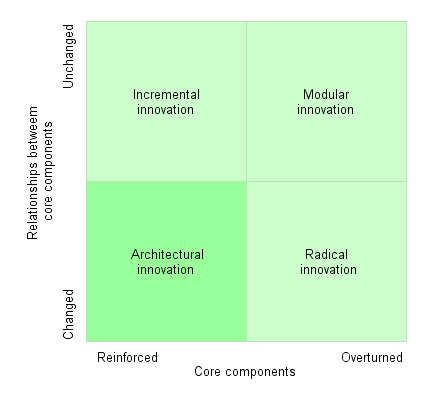Incremental vs. Modular vs. Architectural vs. Radical Innovation
In 1990, Rebecca M. Henderson from MIT and Kim B. Clark from Harvard University wrote an interesting article, Architectural Innovation: The Reconfiguration of Existing Product Technologies and the Failure of Established Firms, which described an innovation typology that was based on an innovation's impact on core design components and/or relationships between them.
- Incremental innovation introduces quality improvements in core components. The word renovation would more precisely describe this type of innovation.
- Modular innovation may result in the complete redesign of core components, while leaving linkages between the components unchanged.
- Architectural innovation changes the nature of interactions between core components, while reinforcing the core design concepts.
- Radical innovation introduces a new meaning, potentially a paradigm shift.

Key Points
UOA creates digital constructs that provide interactional and operational support to organizational units. An organizational unit is a social system, which represents a social technology phenomenon programmed to some purpose(s).
UOA views the organization as an implementation of the Composite design pattern with every node treated either as a Composite (control unit) or a Leaf (functional unit).
Unit software must be as comfortable to an organizational unit as a house is to a family, a space station to an astronaut crew, or a battle tank to a fighting crew.
Each unit must have a formal [software] boundary, which represents a contract between the unit and other entities inside and outside of the organization.
Each unit runs its own operations implemented as executable business processes. Every process in the organization is owned by exactly one unit. A unit might engage another unit or organization to perform a task within the context of the process it owns.
UOA places a special emphasis on control units, which today often consist of just one or a few people, have inadequate information support, and, therefore, have become the weakest links in modern organizations.
UOA uses Systems Thinking for defining the problem, Organization Design for configuring both an enterprise and a composite unit, SOA for constructing unit boundaries, EDA for inter-unit communication, BPM for defining unit operations, and Business Rules for governance.